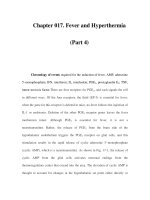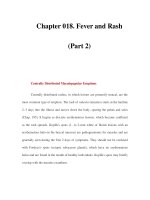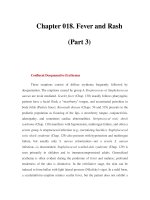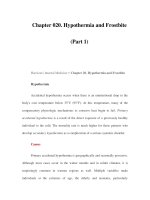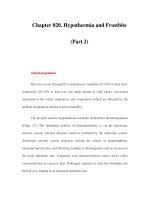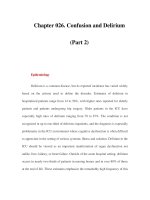Chapter 046. Sodium and Water (Part 2) potx
Bạn đang xem bản rút gọn của tài liệu. Xem và tải ngay bản đầy đủ của tài liệu tại đây (14.01 KB, 5 trang )
Chapter 046. Sodium and Water
(Part 2)
Water Excretion
In contrast to the ingestion of water, its excretion is tightly regulated by
physiologic factors. The principal determinant of renal water excretion is
arginine vasopressin (AVP; formerly antidiuretic hormone), a polypeptide
synthesized in the supraoptic and paraventricular nuclei of the hypothalamus and
secreted by the posterior pituitary gland. The binding of AVP to V
2
receptors on
the basolateral membrane of principal cells in the collecting duct activates
adenylyl cyclase and initiates a sequence of events that leads to the insertion of
water channels into the luminal membrane. These water channels that are
specifically activated by AVP are encoded by the aquaporin-2 gene (Chap. 334).
The net effect is passive water reabsorption along an osmotic gradient from the
lumen of the collecting duct to the hypertonic medullary interstitium. The major
stimulus for AVP secretion is hypertonicity. Since the major ECF solutes are Na
+
salts, effective osmolality is primarily determined by the plasma Na
+
concentration. An increase or decrease in tonicity is sensed by hypothalamic
osmoreceptors as a decrease or increase in cell volume, respectively, leading to
enhancement or suppression of AVP secretion. The osmotic threshold for AVP
release is 280–290 mosmol/kg, and the system is sufficiently sensitive that plasma
osmolality varies by no more than 1–2%.
Nonosmotic factors that regulate AVP secretion include effective
circulating (arterial) volume, nausea, pain, stress, hypoglycemia, pregnancy, and
numerous drugs. The hemodynamic response is mediated by baroreceptors in the
carotid sinus. The sensitivity of these receptors is significantly lower than that of
the osmoreceptors. In fact, depletion of blood volume sufficient to result in a
decreased mean arterial pressure is necessary to stimulate AVP release, whereas
small changes in effective circulating volume have little effect.
To maintain homeostasis and a normal plasma Na
+
concentration, the
ingestion of solute-free water must eventually lead to the loss of the same volume
of electrolyte-free water. Three steps are required for the kidney to excrete a water
load: (1) filtration and delivery of water (and electrolytes) to the diluting sites of
the nephron; (2) active reabsorption of Na
+
and Cl
–
without water in the thick
ascending limb of the loop of Henle (TALH) and, to a lesser extent, in the distal
nephron; and (3) maintenance of a dilute urine due to impermeability of the
collecting duct to water in the absence of AVP. Abnormalities of any of these
steps can result in impaired free water excretion, and eventual hyponatremia.
Sodium Balance
Sodium is actively pumped out of cells by the Na
+
, K
+
-ATPase pump. As a
result, 85–90% of all Na
+
is extracellular, and the ECF volume is a reflection of
total body Na
+
content. Normal volume regulatory mechanisms ensure that Na
+
loss balances Na
+
gain. If this does not occur, conditions of Na
+
excess or deficit
ensue and are manifest as edematous or hypovolemic states, respectively. It is
important to distinguish between disorders of osmoregulation and disorders of
volume regulation since water and Na
+
balance are regulated independently.
Changes in Na
+
concentration generally reflect disturbed water homeostasis,
whereas alterations in Na
+
content are manifest as ECF volume contraction or
expansion and imply abnormal Na
+
balance.
Sodium Intake
Individuals eating a typical western diet consume approximately 150 mmol
of NaCl daily. This normally exceeds basal requirements. As noted above, sodium
is the principal extracellular cation. Therefore, dietary intake of Na
+
results in ECF
volume expansion, which in turn promotes enhanced renal Na
+
excretion to
maintain steady state Na
+
balance.
Sodium Excretion
(See also Chap. 272) The regulation of Na
+
excretion is multifactorial and
is the major determinant of Na
+
balance. A Na
+
deficit or excess is manifest as a
decreased or increased effective circulating volume, respectively. Changes in
effective circulating volume tend to lead to parallel changes in glomerular
filtration rate (GFR). However, tubule Na
+
reabsorption, and not GFR, is the major
regulatory mechanism controlling Na
+
excretion. Almost two-thirds of filtered Na
+
is reabsorbed in the proximal convoluted tubule; this process is electroneutral and
isoosmotic. Further reabsorption (25–30%) occurs in the TALH via the apical
Na
+
-K
+
-2Cl
–
co-transporter; this is an active process and is also electroneutral.
Distal convoluted tubule reabsorption of Na
+
(5%) is mediated by the thiazide-
sensitive Na
+
-Cl
–
co-transporter. Final Na
+
reabsorption occurs in the cortical and
medullary collecting ducts, the amount excreted being reasonably equivalent to the
amount ingested per day.


